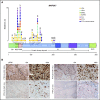Mutations of MAP2K1 are frequent in pediatric-type follicular lymphoma and result in ERK pathway activation
- PMID: 28533310
- PMCID: PMC5520474
- DOI: 10.1182/blood-2017-03-776278
Mutations of MAP2K1 are frequent in pediatric-type follicular lymphoma and result in ERK pathway activation
Abstract
Pediatric-type follicular lymphoma (PTFL) is a B-cell lymphoma with distinctive clinicopathological features. Recently, recurrent genetic alterations of potential importance for its pathogenesis that disrupt pathways associated with the germinal center reaction (TNFRSF14, IRF8), immune escape (TNFRSF14), and anti-apoptosis (MAP2K1) have been described. In an attempt to shed more light onto the pathogenesis of PTFL, an integrative analysis of these mutations was undertaken in a large cohort of 43 cases previously characterized by targeted next-generation sequencing and copy number array. Mutations in MAP2K1 were found in 49% (20/41) of the cases, second in frequency to TNFRSF14 alterations (22/41; 54%), and all together were present in 81% of the cases. Immunohistochemical analysis of the MAP2K1 downstream target extracellular signal-regulated kinase demonstrated its phosphorylation in the evaluable cases and revealed a good correlation with the allelic frequency of the MAP2K1 mutation. The IRF8 p.K66R mutation was present in 15% (6/39) of the cases and was concomitant with TNFRSF14 mutations in 4 cases. This hot spot seems to be highly characteristic for PTFL. In conclusion, TNFRSF14 and MAP2K1 mutations are the most frequent genetic alterations found in PTFL and occur independently in most cases, suggesting that both mutations might play an important role in PTFL lymphomagenesis.
Figures


Similar articles
-
Genome-wide analysis of pediatric-type follicular lymphoma reveals low genetic complexity and recurrent alterations of TNFRSF14 gene.Blood. 2016 Aug 25;128(8):1101-11. doi: 10.1182/blood-2016-03-703819. Epub 2016 Jun 2. Blood. 2016. PMID: 27257180 Free PMC article.
-
A unifying hypothesis for PNMZL and PTFL: morphological variants with a common molecular profile.Blood Adv. 2022 Aug 23;6(16):4661-4674. doi: 10.1182/bloodadvances.2022007322. Blood Adv. 2022. PMID: 35609565 Free PMC article.
-
Pediatric-type follicular lymphoma and pediatric nodal marginal zone lymphoma: additional evidence to support they are a single disease with variation in the histologic spectrum.Virchows Arch. 2024 Nov;485(5):889-900. doi: 10.1007/s00428-024-03941-2. Epub 2024 Oct 8. Virchows Arch. 2024. PMID: 39379519 Free PMC article.
-
The molecular landscape and other distinctive features of primary cutaneous follicle center lymphoma.Hum Pathol. 2020 Dec;106:93-105. doi: 10.1016/j.humpath.2020.09.014. Epub 2020 Oct 9. Hum Pathol. 2020. PMID: 33045225 Review.
-
Premalignant cell dynamics in indolent B-cell malignancies.Curr Opin Hematol. 2015 Jul;22(4):388-96. doi: 10.1097/MOH.0000000000000159. Curr Opin Hematol. 2015. PMID: 26049761 Review.
Cited by
-
Machine learning models-based on integration of next-generation sequencing testing and tumor cell sizes improve subtype classification of mature B-cell neoplasms.Front Oncol. 2023 Aug 3;13:1160383. doi: 10.3389/fonc.2023.1160383. eCollection 2023. Front Oncol. 2023. PMID: 37601650 Free PMC article.
-
A high definition picture of key genes and pathways mutated in pediatric follicular lymphoma.Haematologica. 2019 Sep;104(9):e406-e409. doi: 10.3324/haematol.2018.211631. Epub 2019 Feb 28. Haematologica. 2019. PMID: 30819919 Free PMC article. No abstract available.
-
The clinical and molecular taxonomy of t(14;18)-negative follicular lymphomas.Blood Adv. 2023 Sep 26;7(18):5258-5271. doi: 10.1182/bloodadvances.2022009456. Blood Adv. 2023. PMID: 37561599 Free PMC article.
-
Pediatric lymphomas: overview and diagnostic challenges.Virchows Arch. 2025 Jan;486(1):81-100. doi: 10.1007/s00428-024-03980-9. Epub 2024 Dec 21. Virchows Arch. 2025. PMID: 39707053 Free PMC article. Review.
-
Genomic profiling for clinical decision making in lymphoid neoplasms.Blood. 2022 Nov 24;140(21):2193-2227. doi: 10.1182/blood.2022015854. Blood. 2022. PMID: 36001803 Free PMC article.
References
-
- Quintanilla-Martinez L, Sander B, Chan JK, et al. . Indolent lymphomas in the pediatric population: follicular lymphoma, IRF4/MUM1+ lymphoma, nodal marginal zone lymphoma and chronic lymphocytic leukemia. Virchows Arch. 2016;468(2):141-157. - PubMed
Publication types
MeSH terms
Substances
LinkOut - more resources
Full Text Sources
Other Literature Sources
Research Materials
Miscellaneous

